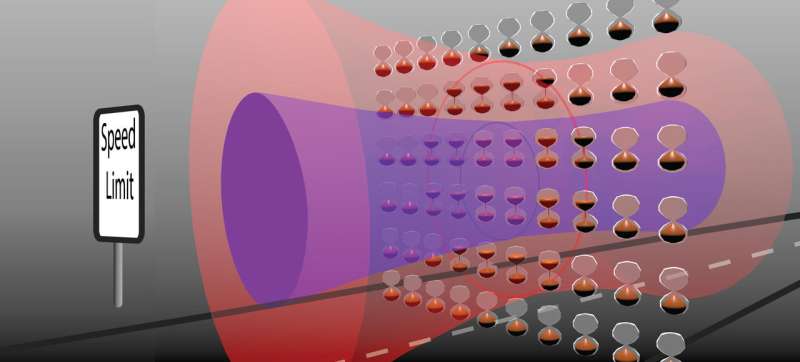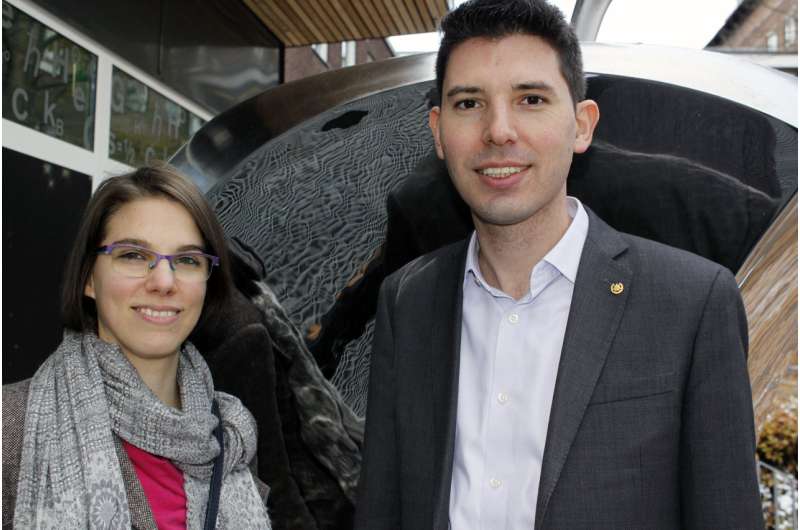Researchers at Chalmers University of Technology have discovered why there is a speed limit on how fast the properties of light can be changed with the help of specially designed materials. This new understanding can point the way forward for the next generation of consumer electronics, such as smart watches, screens and glasses. Credit: Sophie Viaene and Vincent Ginis
Speed limits apply not only to traffic. There are limitations on the control of light as well, in optical switches for internet traffic, for example. Physicists at Chalmers University of Technology now understand why it is not possible to increase the speed beyond a certain limit—and know the circumstances in which it is best to opt for a different route.
Light and other electromagnetic waves play a crucial role in almost all modern electronics, for example in our mobile phones. In recent years researchers have developed artificial speciality materials—known as optomechanical metamaterials—which overcome the limitations inherent in natural materials, in order to control the properties of light with a high degree of precision.
For example, what are termed optical switches are used to change the colour or intensity of light. In internet traffic these switches can be switched on and off up to 100 billion times in a single second. But beyond that the speed cannot be increased any further. These unique speciality materials are also subject to this limit.
"Researchers had high hopes of achieving higher and higher speeds in optical switches by further developing optomechanical metamaterials. We now know why these materials failed to outcompete existing technology in internet traffic and mobile communication networks," says Sophie Viaene, a nanophotonics researcher at the Department of Physics at Chalmers.
Chalmers researchers Sophie Viaene and Philippe Tassin recently published their research findings in nanophotonics in the well-respected journal Physical Review Letters. They have determined what direction to take in their area of research. Credit: Mia Halleröd Palmgren/ Chalmers University of Technology
To find out why there are speed limits and what they mean, Viaene went outside the field of optics and analysed the phenomenon using what is termed non-linear dynamics in her doctoral thesis. The conclusion she reached is that it is necessary to choose a different route to circumvent the speed limits: instead of controlling an entire surface at once, the interaction with light can be controlled more efficiently by manipulating one particle at a time. Another way of solving the problem is to allow the speciality material to remain in constant motion at a constant speed and to measure the variations from this movement.
But Viaene and her supervisor, Associate Professor Philippe Tassin, say that the speed limit does not pose a problem for all applications. It is not necessary to change the properties of light at such high speeds for screens and various types of displays. So there is great potential for the use of these speciality materials here, since they are thin and can be flexible.
Their results have determined the direction researchers should take in this area of research, and the scientific article was recently published in the highly regarded journal Physical Review Letters. The pathway is now open for the ever smarter watches, screens and glasses of the future.
"The switching speed limit is not a problem in applications where we see the light, because our eyes do not react all that rapidly. We see a great potential for optomechanical metamaterials in the development of thin, flexible gadgets for interactive visualisation technology," says Tassin, an associate professor in the Department of Physics at Chalmers.
More information: Sophie Viaene et al, Do Optomechanical Metasurfaces Run Out of Time?, Physical Review Letters (2018). DOI: 10.1103/PhysRevLett.120.197402
Journal information: Physical Review Letters
Provided by Chalmers University of Technology
























